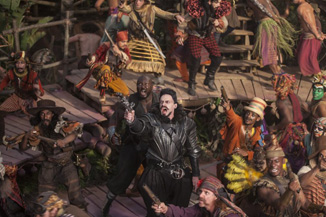Monday Morning Quarterback Part II
By BOP Staff
October 14, 2015
Kim Hollis: What is the element that makes a fairy tale/fantasy adaptation succeed? What is it about movies like Alice in Wonderland, Maleficent, and Cinderella that brings success versus movies like Pan, Jack the Giant Slayer or Mirror Mirror?
Ben Gruchow: These six examples are all ultimately best answerable on a case-by-case basis, but Alice in Wonderland: Tim Burton as a brand. Maleficent: Angelina Jolie. Without her, I'm confident this would have bombed. Cinderella was clearly a straight-ahead retelling of the story, classically filmed, without any kind of twist. All of them were ultimately safe, corporatized films, just like a live-action Disney movie will be: I don't think anyone over the age of 14 thought any of the three were going to be amazing, but you know you're getting a certain baseline of competency and quality.
Timing was also a big factor: Alice in Wonderland, Maleficent, and Cinderella were all released at least a month away from the last big film that shared the same audience. In Alice's case, it was several months. There's also a big difference between the first of these and the second and third in terms of earnings.
Apart from that: Pan opened in the shadow of The Martian (which pulled in more family audiences more than I expected), and we've already seen that audiences are paying a surprising amount of attention to reviews this year. The closest thing to a brand reference you can get with Jack the Giant Slayer is Jack and the Beanstalk, which was (I'd argue) not an exciting enough brand. Mirror Mirror looked as silly and inconsequential as it was, and it also got crushed by The Hunger Games like everything else in late March.
So I guess the lesson is: um, be Disney. Be Disney if you're going to do a fairy tale, be Disney if you're going to do a fairy tale with a wrinkle, and especially be Disney if you're going to release a fairy tale outside of summer.
Edwin Davies: To build on what Ben said, and as I alluded to in my answer to the previous question, Disney has had a monopoly on these kinds of stories (and on these specific characters) for generations. Even though the likes of Cinderella, Alice In Wonderland and Snow White all existed prior to Disney and have been realized in lots of different versions over the years, the Disney animated ones have been the definitive ones, and as such all Disney-sanctioned updates like Alice and Cinderella have a ring of authenticity to them that Pan and Mirror, Mirror lack.
It's also worth noting that the more successful versions of these films often (though not always) offer something new. Burton's Alice in Wonderland was a sequel to the original and promised a new story with familiar characters; Snow White and the Huntsman took the Snow White story and pushed it into the high fantasy genre in an interesting way; Maleficent told the Sleeping Beauty story from a different perspective. Pan, despite being a prequel, just looked like a rehash of a story we've all seen before, but with some of the names changed.
Continued:
1
2
|
|
|
|




